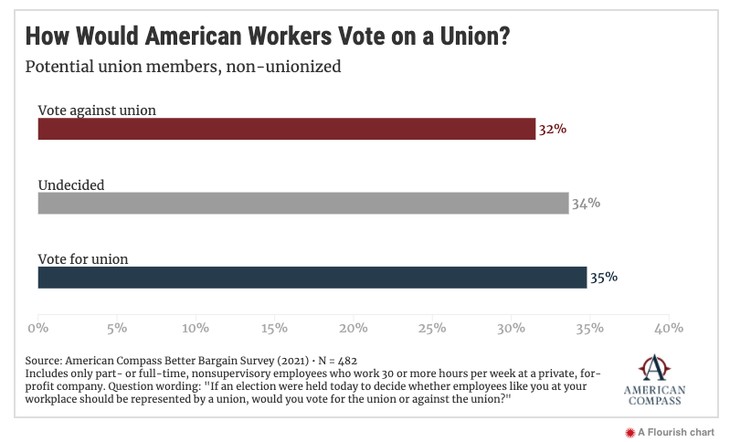The labor rights movement created Labor Day in the late 19th century. Seen as a celebration of the American worker, it became a federal holiday in 1894. The labor movement brought about fundamental changes in the employer-employee relationship. The movement’s activism for workers’ rights ended many abusive employer practices and made dangerous jobs much safer.
The movement achieved the passage of the National Labor Relations Act of 1935, which outlined the rules and procedures for collective bargaining and created the National Labor Relations Board. Shortly after that, the Fair Labor Standards Act passed in 1938, establishing the 40-hour workweek, federally mandated overtime pay, and child labor protections. The push for workplace safety culminated in the Occupational Safety and Health Act of 1970 (OSHA), which established the Occupational Safety and Administration to oversee working conditions.
Private-sector union density peaked a little more than ten years after the passage of OSHA. Since 1983, private-sector union density has declined while, unfortunately, public-sector membership has remained relatively stable. Even President Franklin Delano Roosevelt wrote that collective bargaining has “insurmountable limitations when applied to public personnel management.” Essentially, these groups bargain against the taxpayer at the local, state, and federal levels where they exist.
Image via USAFacts.org
A new poll from American Compass gives some insight into these trends. The Better Bargain Survey seeks opportunities for a reinvigorated modern labor movement that serves workers’ needs. It sampled 3,000 working adults between the ages of 18 and 65. One item it measured was workers’ attitudes about their jobs and organized labor. According to their findings, the national labor movement’s excessive political involvement is the number one obstacle to growing private-sector unions.
According to the results among private-sector employees (part- or full-time employees who work 30 or more hours per week at private, for-profit companies in non-supervisory roles):
- By a three-to-one margin, potential union members say they would prefer a worker organization that focuses only on workplace issues to one that is also engaged in national political issues.
- When asked where workers want a union to spend their time, potential union members assigned half their weight to collective bargaining and providing training and benefits, versus 3% to politics.
- The top reason for voting no is union involvement in politics; by contrast, fear of retaliation is the least cited for voting no.
- Across nearly 20 political issues highlighted by the AFL-CIO and SEIU, not a single one was chosen by a majority of potential union members as something they would want to see a worker organization focus on.
The survey asked workers not in a union if they would vote to join one, and it is easy to see why employers can rebuff many union organizing drives. A third of workers are predisposed to vote no, and the persuadable pool is as large as those who would vote yes.

According to the survey, workers are apathetic to the current form of the labor movement. Middle and upper-class Democrats hold the most favorable views of labor unions, which could be why Alexandria Ocasio-Cortez can’t stop yapping about them. The survey also found that many employees are content to work directly with management and prefer an organization run jointly by management and employees. Workers also like to be represented by a coworker rather than an outsider. They want these organizations to work on collective bargaining, benefits and training, and workplace collaboration.
Related: Dems’ Union Bill Would Tax Workers and Cost Jobs, New Study Finds
As social scientist Eric Hoffer wrote in 1967,”Every great cause begins as a movement, becomes a business, and eventually degenerates into a racket.” Hoffer was writing about the civil rights movements of the 1960s, but we can also apply his assessment to big labor. Through a legitimate campaign for workers’ rights, labor leaders secured wage and hour protections and improved occupational safety. The government took over the enforcement of wage and hour laws and the regulation of occupational safety.
Employers figured out that worker satisfaction and safety increased productivity. Through thoughtful employee relations programs, they can provide forums that include management and employees for collaboration and problem-solving. Training and opportunities increase retention. Workers have not been viewed as particularly replaceable for most private-sector employers for some time, increasing employer interest in keeping their skills up to date and keeping them healthy.
The traditional adversarial labor-management relationship does not serve employees in the 21st century economy. Unions have also not delivered on wages and benefits above non-union labor market trends in some time. Most unionized employees have traded wages for healthcare benefits. You may remember union opposition to the Obamacare Cadillac tax and other moves to nationalized plans. Bargaining to preserve rich benefit plans rather than salary is the root of that opposition. Many have also had at least a portion of their pension converted to 401ks or other defined contribution programs.
Related: Pete Buttigieg’s ‘Learn to Code’ Moment and the Canard of High-Paying Green Union Jobs
Lacking a compelling sales pitch, national labor unions had to turn to politics to maintain their power and influence. The Service Employees International Union pushes a $15 minimum wage to protect its dues income. The employees they are trying to organize know that raising the wage will just increase the pace of automation.
The AFL-CIO took an active role in the shadow campaign to elect Joe Biden, according to Time. While this benefited workers by securing the first public bailout of private-sector pensions, there is not much else on the agenda. The PRO Act serves to preserve union density and increase dues by eliminating “right to work” laws, reducing the ability of workers to contract and freelance, and eliminating employer actions to rebuff an organizing drive.
Biden’s green agenda is already eliminating good-paying union jobs in pipeline construction and the oil and gas industry. The green jobs the climate agenda promises won’t materialize for years, if at all. The global trade agenda that makes Wall Street wealthier and hollows out a large swath of America will only ensure that more manufacturing jobs are lost or relocated as China continues to subsidize the industries it wishes to capture.
The public-sector unions in the AFL-CIO benefit significantly from the labor organization’s political choices. The party that strives to grow government is in power. The teachers’ unions are also protected and have undue influence over education policy. The agenda offers little to the mechanic, the autoworker, or the guy on the oil rig.
We should celebrate the American worker and the successful movement to secure worker protections. The private-sector union should continue to go the way of the dodo. And public-sector unions remain an abomination.










